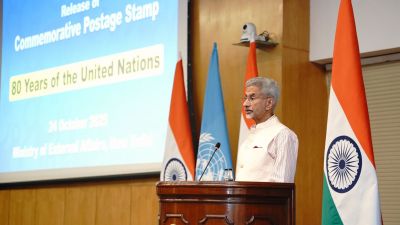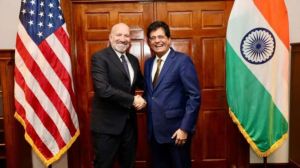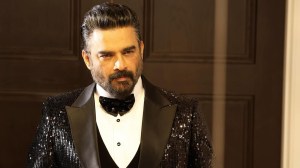Kapil’s shin, Bhajji’s clout
For a sport built around history, statistics and tradition, isn’t it amazing how short our memories can be?

For a sport built around history, statistics and tradition, isn’t it amazing how short our memories can be? So just go back 15 years, to Port Elizabeth, the second of the seven-match ODI series being played between India and South Africa. Remember also that this series marked South Africa’s re-entry into international sport after the anti-apartheid boycott. It was also considered entirely fitting that the country that offered to break the freeze was India, always in the forefront of the anti-apartheid movement. In fact, in my cricket memorabilia someplace I still have a cap from that tour, with “Friendship Series, 1992-93” embroidered on it with golden thread.
But do you also remember some unusual things that happened on that tour? Yes, there was the Sachin run-out in South Africa, unusual because it was the first time the umpire referred a decision to the third umpire. And then another umpire, Steve Bucknor, refused to refer a similar situation involving Jonty Rhodes to the TV umpire who would have certainly ruled him out. Both incidents have found mention in the post-Sydney coverage in the past week. But one hasn’t, and that is what I am complaining about and so, we go back to Port Elizabeth, December 9, 1992, second ODI.
Peter Kirsten (brother of Gary, the new coach) was then one of most prolific scorers for South Africa and, Kapil Dev, the India captain, had already warned him thrice against his habit of taking a start, as non-striker, before the ball was bowled. Technically, the bowler can run a batsman out like this, but in cricket, it is not usually the done thing. But because Kirsten persisted, Kapil now did run him out. Kirsten went out swearing, the crowd was incensed and so, it seems, was Kepler Wessels, the then South African captain, batting at the other end. So angry he was, indeed, that in the same over, he pretended to collide with the bowler (Kapil) while turning for a second run and knocked him in the shin with his bat. A little footnote here may be relevant: through years of apartheid, Wessels had played his cricket in Queensland and, even scored a century on debut as an opener for Australia. Like Ponting’s team, he had also, obviously, learnt his cricketing manners there.
Kapil’s team-mates were furious. Many told reporters on that tour that the knock left a sizeable bruise on Kapil’s shin — in fact, anybody who saw him double up with pain at that point would have figured that. But he did not retaliate. India did complain that Wessels hit Kapil deliberately, but made no big deal of it. BCCI was afraid of a diplomatic incident and played it down. There was a routine hearing by the match referee, Clive Lloyd, who claimed he had seen nothing and that the TV replays were inconclusive. But he fined Wessels half his match fees anyway.
More important, however, is Kapil’s conduct. The same Kapil who, for two generations of Indians, has represented the aggressive, no-nonsense, never-say-die face of Indian cricket. He took both the insult and the injury with a stoicism not expected of an international cricketer, least of all if he answers to the name Kapil Dev. In so many ways, that incident set the tone of that tour as South Africa beat us in both forms of the game, bullying and glaring.
I have never got a satisfactory answer from Kapil on why he responded so uncharacteristically meekly. In fact, Imran Khan once said to me — on the record — that he was shocked by Kapil’s pusillanimity and, God forbid, if Wessels had him, or a Pakistani in his team, there would have been hell to pay. Particularly for a nation still fighting its way out of the anti-apartheid boycott. The question we need to ask is, would a Wessels have dared to do such a thing today? And if he had, not to one of India’s great stars, or its captain, but even to one of its junior team members, would he have got away the same way? The answer is an obvious no. And that is what has changed in world cricket. Which is why, apparently, when told to f..k off twice by Andrew Symonds, Harbhajan did not offer the other cheek, or mutter an apology and back off.
This is not to justify the use of any bad language on the field, least of all a racist slur. But the days when subcontinental players were so much in awe of the white man that they put up with a nasty knock on the shin are over. Imran Khan often says that one of his biggest problems taking Pakistan out on tours initially used to be this. His players would compulsively address the white opponent as ‘sir’. He instructed them to switch to something more equal, and often something unprintable, in Punjabi. He found his players, mostly picked from the back-lanes of what can probably be described as the subcontinent’s semi-urban outback, had complexes about dressing in western-style suits and ties, so he had them switch to their own salwar-kameez. “It was a struggle to begin with, but it paid off. And since then Englishmen have been scared of Pakistan instead,” he says.
May be Sourav Ganguly brought some of that quality to Indian cricket. But more important than that is the way the centre of gravity of world cricket has now shifted. There was a time when a hundred at Lord’s was such a big deal. Today it isn’t, even in cricketing terms, because England are one of the easier teams to score off — so easy even Ajit Agarkar has a hundred there! There was also a time, until not so long ago, that we listened to the BBC commentary on county cricket when an Indian was featuring: Pataudi for Sussex, Engineer for Lancashire, then Bedi for Northamptonshire. Even Dravid and Tendulkar signing up for Kent and Yorkshire for one season each was news. It’s all changed so dramatically now. Who cares now?
The talk now is about who else is signing up with IPL and even ICL. See some comparative figures. Even an international star can make at best around $60-90,000 per season with a big county club. But an over-the-hill Lara has been signed up by ICL for a million dollars for just one year. McGrath and Warne are apparently being paid $350,000 and $400,000, respectively, for one season by IPL. Here is another interesting factoid: read one of G.S. Vivek’s many brilliant despatches from Australia in this newspaper (January 9, indianexpress.com) and he tells you that the Bhajji-Symmonds spat started when Bhajji patted bowler Brett Lee’s bottom in jest while crossing over for a single. But the Australians did not present Lee as a witness against Bhajji. You know why? Because he did not want to risk his many commercial interests in India, from endorsing Timex to cutting discs with Asha Bhonsle.
Let the English press go blue in the face screaming India is using its financial muscle to arm-twist the ICC. If that muscle is a reality, if 70 per cent of all cricketing revenues come from the subcontinent and if India, Pakistan, Sri Lanka and Bangladesh now show such solidarity on crucial cricketing issues, the world has to learn to live with this new global order. Gone are the days when one Sunil Manohar Gavaskar could be humiliated by being denied entry at Lord’s and elicit not one line in genuine apology. The capital of a game is where the cash, crowds and the crazies are. (Even the ICC has moved its headquarters from holy London to neutral Dubai.) The ICC and even Cricket Australia know it and, wonder of wonders, now even BCCI has realised it. That is why the Bhajji incident — even though in this case the boot may a little bit be on the other leg — will not go down like the Wessels knock on Kapil’s shin.
sg@expressindia.com





- 01
- 02
- 03
- 04
- 05


























